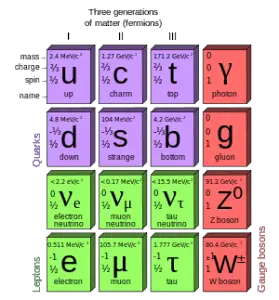 Quarks and electrons are some of the elementary particles. Many fundamental particles have been discovered in various experiments. So many that researchers had to organize them, just like Mendeleev did with his periodic table. This is summarized in a theoretical model (concerning the electromagnetic, weak, and strong nuclear interactions) called the Standard Model. In particle physics, an elementary particle or fundamental particle is a particle whose substructure is unknown. Thus it is unknown whether it is composed of other particles.
Quarks and electrons are some of the elementary particles. Many fundamental particles have been discovered in various experiments. So many that researchers had to organize them, just like Mendeleev did with his periodic table. This is summarized in a theoretical model (concerning the electromagnetic, weak, and strong nuclear interactions) called the Standard Model. In particle physics, an elementary particle or fundamental particle is a particle whose substructure is unknown. Thus it is unknown whether it is composed of other particles.
There are six “flavors” of quarks six quarks in the present Standard Model, just as there are six leptons based on a presumed symmetry in nature. The three quarks originally proposed and accepted were labeled u (up quark), d (down quark), and s (strange quark). The other three quarks are called charmed, bottom, and top. They can successfully account for all known mesons and baryons. The most familiar baryons are the proton and neutron, each constructed from up and down quarks.